These Exact Exercises Reduce Your Risk of Deadly Disease, Says Study

A few years ago, a study published in the American Journal of Epidemiology found that those who strength trained—more so than those who performed primarily cardio exercise—were at a greater reduced risk of early death from cancer. In 2021, a new review of epidemiological research published in the International Journal of Behavioral Nutrition and Physical Activity appears to have a modified—or at least advanced—that conclusion.
The researchers found that strength training indeed reduces your mortality risk associated with cancer. However, the researchers found that combining both strength training and aerobic exercise can reduce your cancer mortality risk even more. What's more, the study even listed some of the strength-training exercises that you can do. Read on for more about what the researchers discovered, and for more exercise news and you can use, see here for The One Exercise You Should Never Skip After 50, Says Science.
Weightlifting Is Great. Both Weightlifting and Cardio Are Better.

"Physical activity has been associated with a reduced risk of several types of cancer, but it was unclear what kinds of exercise had the best results," writes Leandro Rezende, a professor in the Department of Preventive Medicine at the Federal University of São Paulo's Medical School (EPM-UNIFESP) in Brazil, explained in the official release. "In our study, we found evidence that muscle strength training can not only reduce cancer incidence and mortality but also have an even better effect when associated with aerobic activities, such as walking, running, swimming and cycling."
The review, which drew on data of more than 1.2 million people, found that there was a strong connection between physical activity and the risk of these specific cancers: breast, stomach, endometrial, kidney, and bladder. They were not able to correlate exercise and reduced risk of cancers in the colon, prostate, lung, pancreas, esophagus, rectum—in addition to lymphoma, melanoma, and leukemia. For more on how exercise can extend your life, read up on The One Secret Exercise Trick That Can Add Years to Your Life, Says Doctor.
The Review Notes These Moves

The review found that workouts that utilized "squats, rowing, planks, weight training and so on can reduce the probability of dying from cancer by 14%," notes Technology Networks Cancer Research, in a writeup of the study. However, "when these exercises are combined with aerobic activities, the benefit is even greater, potentially reducing mortality by 28%."
How much exercise should you do? Well, the study says that you'd be wise to follow the recommendations of most leading health bodies. "[We] corroborated the recommendations of the World Health Organization (WHO) regarding regular aerobic exercise for adults: 150-300 minutes per week if moderately intense, 75-150 minutes of vigorous exercise, or an equivalent combination. The WHO also recommends twice-weekly strengthening exercises."
Why Does Exercise Help?

The study authors note that they simply do not know why physical activity can reduce your risk of dying from cancer. But they offer a few hypotheses. The first is simple: People who engage in weight training and cardio are less likely to be obese, which in itself lowers the "incidence of cancer." The second is that more muscle mass leads to better glucose control, and that trends such as HIIT—that combine strength training and cardio—"could trigger adaptations in the body by generating more antioxidants," which may have an impact. The final hypothesis: Exercise increases oxygen flow through the body, and "hypoxic" environments—areas low in oxygen—"are important for tumor growth."
Here Are Some Great Workouts You Can Do

Whether you're exercising to feel better, look better, lose weight, or to extend your life (or, truth be told, accomplish them all), here are some great workouts you can try now—many of which use the same moves mentioned above:
- Build Muscle and Get Lean with This 4-Move At-Home Workout.
- Try This Simple Bodyweight Workout to Burn Fat and Get Lean
- Over 60? Here Are 5 of the Best Exercises You Can Possibly Do
- These Are the 5 Best Exercises for Toning Your Abs, Says Trainer
- One Trendy Celeb Exercise Trick You Can Try at Home, Says Trainer
- Do These Exercises for a Toned and Healthy Summer Body, Says Trainer








